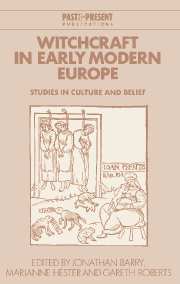Book contents
- Frontmatter
- Contents
- Preface
- Contributors
- 1 Introduction: Keith Thomas and the problem of witchcraft
- PART 1 THE CRIME AND ITS HISTORY
- PART 2 WITCHCRAFT AND RELIGION
- PART 3 THE MAKING OF A WITCH
- PART 4 WITCHCRAFT AND THE SOCIAL ENVIRONMENT
- 10 Witchcraft in early modern Kent: stereotypes and the background to accusations
- 11 Patriarchal reconstruction and witch hunting
- PART 5 DECLINE
- Index
- Past and Present Publications
10 - Witchcraft in early modern Kent: stereotypes and the background to accusations
Published online by Cambridge University Press: 06 July 2010
- Frontmatter
- Contents
- Preface
- Contributors
- 1 Introduction: Keith Thomas and the problem of witchcraft
- PART 1 THE CRIME AND ITS HISTORY
- PART 2 WITCHCRAFT AND RELIGION
- PART 3 THE MAKING OF A WITCH
- PART 4 WITCHCRAFT AND THE SOCIAL ENVIRONMENT
- 10 Witchcraft in early modern Kent: stereotypes and the background to accusations
- 11 Patriarchal reconstruction and witch hunting
- PART 5 DECLINE
- Index
- Past and Present Publications
Summary
The study of witchcraft has been one of the best ploughed fields in the landscape of early modern social history. There is scarcely an aspect of the accusation and prosecution of witches which has not been confronted, hardly a legal archive which has not been ransacked by scholars eager to make their contribution to one of the darker chapters of Europe's past. Yet it is clear that the greater part of this research, even among English-speaking scholars, has concerned continental as distinct from English witchcraft, an imbalance attributable in the main to the towering achievements of Alan Macfarlane and Keith Thomas whose books were published in 1970 and 1971 respectively. A quarter of a century later, theirs is still the dominant interpretation, but it is clear that the time is now ripe for a reappraisal of the English experience of witchcraft, especially when one considers the occasionally limited scope and overly theoretical structuring of their research. Despite his chosen title, Macfarlane's survey remains essentially a study of Essex – a county sometimes mistaken for a country by social historians overawed by its bountiful records, and keen to see national resonance in the events and characteristics of the locality. Furthermore, although Thomas' instincts and industry were formidable, he himself admits that his search of local archives was incomplete. This chapter is based upon a primarily qualitative analysis of the prosecution of witches in the south-eastern county of Kent after 1560, and seeks to demonstrate how the anthropological framework constructed by Thomas and Macfarlane should perhaps be adjusted or applied more selectively.
- Type
- Chapter
- Information
- Witchcraft in Early Modern EuropeStudies in Culture and Belief, pp. 257 - 287Publisher: Cambridge University PressPrint publication year: 1996
- 3
- Cited by

